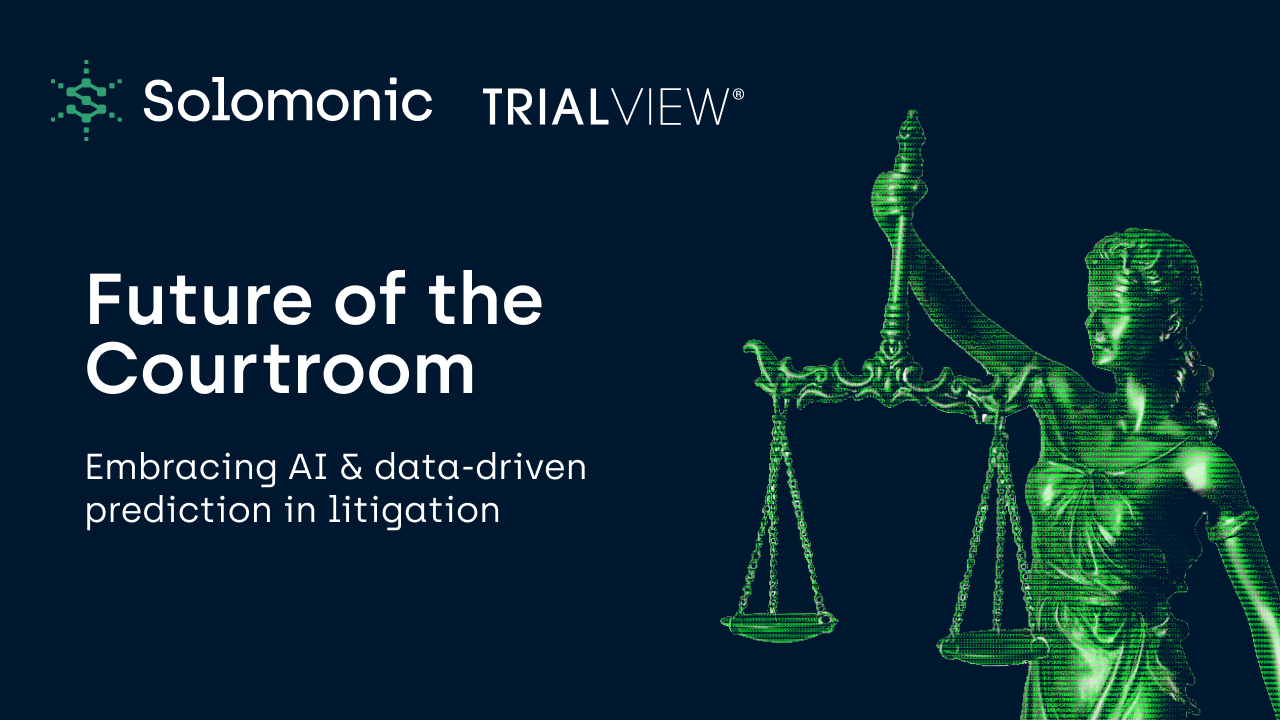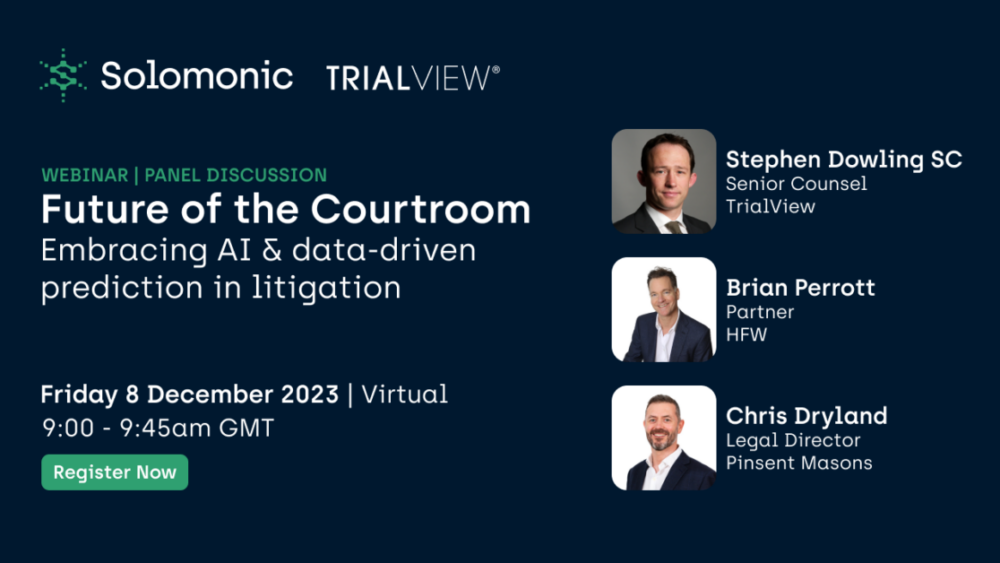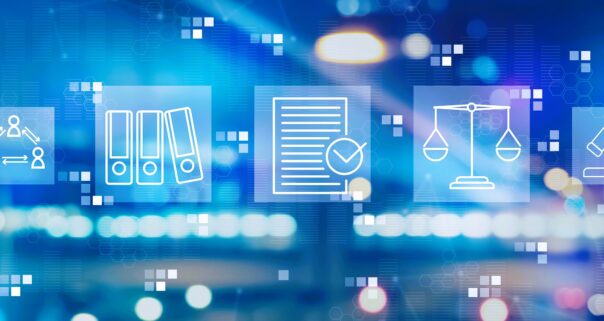Generative AI has taken the world by storm. The impact on knowledge driven tasks and work is expected to be huge.
At the same time and with less attention, predictive modelling of litigation has been advancing significantly. Solomonic has been developing forecasting models using structured data that show high degrees of accuracy and indicate the ability to predict not only outcomes, but duration, and possibly arguments in the future.
The advances we are seeing are happening very quickly and pose a significant set of challenges for lawyers, their roles, and the future courtroom.
On 8th December 2023, Solomonic and TrialView joined forces to host an online discussion on the topic. We assembled a panel of leading practitioners and innovators, to explore how practitioners can not only think more creatively, but indeed thrive, in a landscape of AI and data-driven prediction.
Brian Perrott, Partner and Head of Innovation at HFW; Chris Dryland, Legal Director at Innovation award winning firm Pinsent Masons; and Stephen Dowling, Senior Counsel and CEO of TrialView, engaged in a thought-provoking panel, covering the full spectrum of potential shifts in the disputes sector.
AI: From Prep to Hearing
The session opened with a discussion on the revolutionary potential of AI. As a language-based technology, AI’s prowess in manipulating, understanding, and predicting language is positioned to be a game-changer in the preparation stages of litigation. AI’s ability to handle and analyse vast amounts of data surrounding disputes promises a significant transformation in how legal professionals approach and manage evidence, and caseloads.
Dowling noted, “If you think about any event that occurs these days, particularly in commercial litigation, it is surrounded by and immersed in some kind of data trail – chains of emails, Slack messages, WhatsApp, letters, bodies of correspondence. That job we do as litigators where we are parsing information down will be radically transformed by AI.”
This capacity for data analysis, including pattern recognition and language understanding, is predicted to play a pivotal role in building compelling cases, and feeding into strategic legal decisions. Whilst the implications of AI are all pervasive, flowing from early case management through to the courtroom, our panel collectively opined that the human touch will remain imperative in advocacy and persuasion.
Litigation Risk and Settlement
A central theme of the discussion was the potential of AI to mitigate litigation risk. Leveraging insights and patterns from data has the potential to completely transform the dynamics of dispute resolution, offering some sense of predictability in a fluctuating legal sector.
Perrott explained, “If you can focus on reducing the risk and making things more predictable, then the logical conclusion is that people would settle disputes because the answer is clearer, and the outcome is easier to predict. Solomonic is creating a new galaxy of opportunity, with data, looking at the performance of experts, judges, barristers, the past record. Of course, that doesn’t always inform the future, but it helps.”
By encouraging a culture of always thinking about how to make litigation less unpredictable, it was felt that we could see speedier resolution; conversely, panellists explored the concept that increased predictability may alleviate the fear associated with going to trial, with the potential to inflate litigation.
AI’s Role in Witness Preparation
The panellists delved into AI’s impact on witness preparation, highlighting the potential for real-time analysis of statements, identifying inconsistencies, and enhancing overall preparation processes. While AI brings efficiency to the preparation phase, it was felt that human judgment remains crucial in assessing witness performance and making strategic decisions during trial.
Dryland emphasised, “It is that human element which is irreplaceable by AI. It is really important that be elevated in terms of how we think witnesses will perform in the witness box, and tactical issues in terms of when to settle.”
Challenges and Considerations
The webinar addressed various challenges associated with the integration of AI in dispute resolution, including accountability for erroneous findings, and the need for human expertise in directing AI tools. Notably, panellists discussed the evolving nature of economic models in the legal profession, asking whether law firms should charge clients specifically for AI services, and whether AI could finally be the catalyst to shift away from the billable hour. The consensus emerged that the value brought by litigators will require a radical change in the face of AI and data prediction.
Predictions for the future
The panellists envisioned a future where AI is viewed through a collaborative lens, leading to more efficient trial preparation, shorter proceedings, and increased access to justice by reducing overall litigation costs. Whether the courtroom of the future will comprise of a robo-judge or clerk was still up for much debate. The need for responsible use, human expertise and a very thoughtful approach to evolving technology ranked high. We were left with a lot of food for thought, including the pertinent question, with the inexorable acceleration of AI universally, will lawyers share the risks with clients, if this means saving on time and costs?
Ultimately, it was agreed that AI and data prediction are integral to the future of the legal landscape. Practitioners seeking to stay at the forefront will recognise the need for adaptability and strategic utilisation of these tools now.
Perrott summarised, “I would encourage all those litigators, if they haven’t discovered a world of data prediction, to make it part of your litigation DNA, because it’s here to stay, and I find it very useful.”
Access the full webinar recording on this link.







